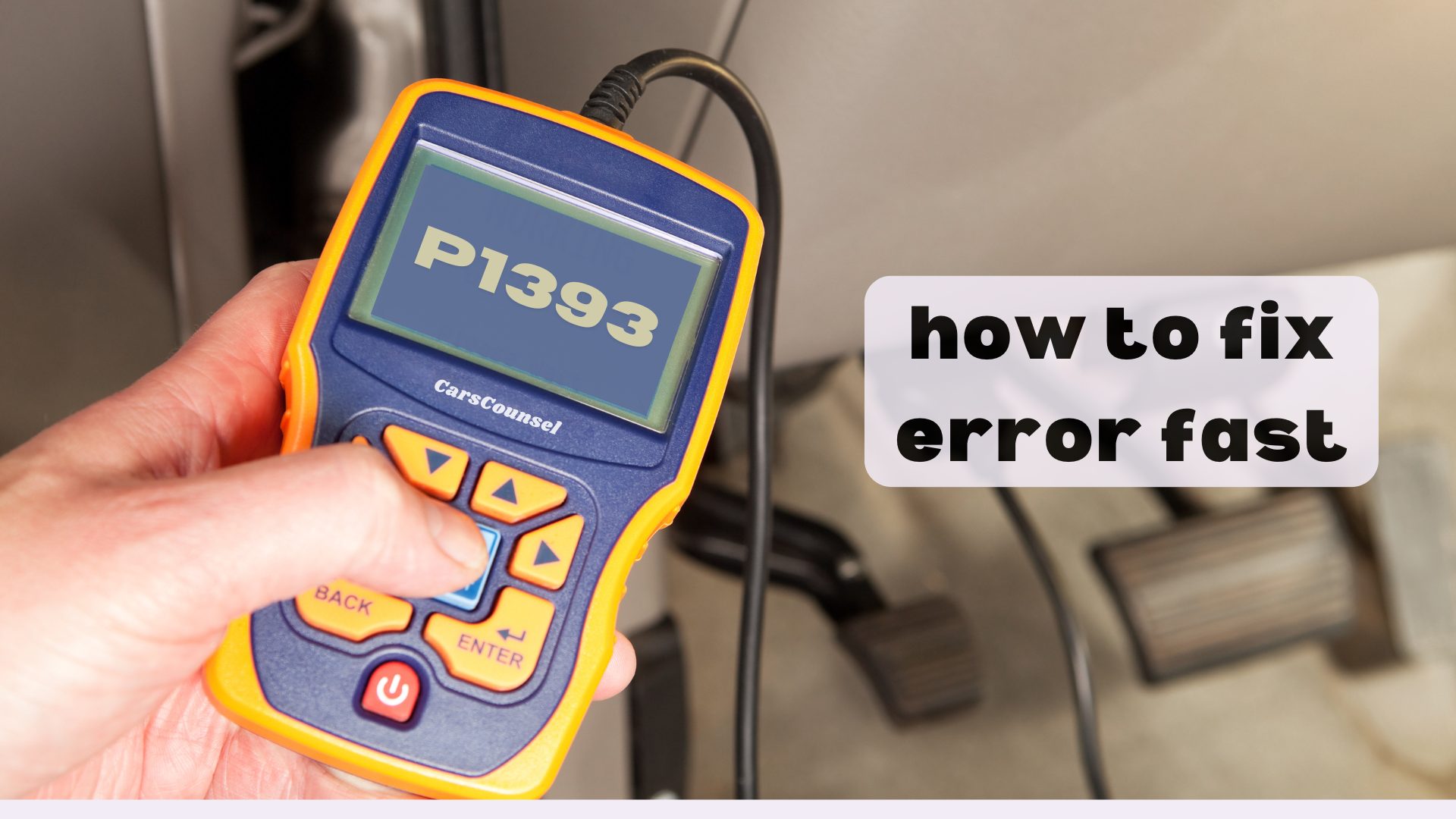You’re faced with the P1393 code, indicating a problem with the glow plug circuit on Bank 2 of your engine. This can lead to frustrating difficulties starting the engine, reduced performance, and increased emissions. But what’s causing the issue?
Is it a faulty glow plug, a wiring or connection problem, or perhaps an issue with the engine control module? Identifying the root cause is key to fixing the problem, and that’s where you need to start. You’ll want to investigate the possible causes and diagnostic steps to get your engine running smoothly again.

Quick Navigation
Key Takeaways
- The P1393 code indicates a problem with the glow plug circuit on Bank 2, essential for cold starts, and can lead to difficulties starting the engine.
- Common causes of P1393 include faulty glow plugs, wiring or connection issues, problems with the glow plug relay, and issues with the engine control module (ECM).
- The glow plug circuit provides necessary heat to ignite the fuel-air mixture when the engine is cold, and diagnosing the specific issue is necessary to fix the problem.
- Symptoms of a faulty glow plug include hard starting, rough idling, misfires, and the check engine light illuminating on the dashboard.
- Replacing faulty glow plugs, repairing wiring and connectors, and addressing ECM issues may be necessary to resolve the P1393 code.
Code P1393 Description and Causes
When your diesel engine’s check engine light illuminates, it can be frustrating and unsettling.
The P1393 code indicates a problem with the glow plug circuit on Bank 2 of your engine, which is essential for cold starts. This fault code can lead to difficulties starting the engine, reduced performance, and increased emissions.
The glow plug circuit provides the necessary heat to ignite the fuel-air mixture when the engine is cold.
Common causes of P1393 include faulty glow plugs on Bank 2, wiring or connection issues, problems with the glow plug relay, issues with the engine control module (ECM), and corrosion or damage to the glow plug connectors.
You’ll need to diagnose the specific issue to fix the problem.
Glow Plug Circuit Function and Purpose
The diesel engine’s glow plug circuit plays a vital role in facilitating cold starts by providing the necessary heat to ignite the fuel-air mixture in the combustion chamber.
As you know, diesel engines rely on high compression to ignite the fuel, but this process can be difficult when the engine is cold.
That’s where the glow plug circuit comes in – it helps to heat up the combustion chamber, allowing for easier starts.
The glow plug circuit is fundamentally an electrical heating element that warms up the combustion chamber, making it possible for the fuel to ignite.
Common Issues With Glow Plugs
As you plunge into the world of diesel engines, you’ll likely encounter issues with glow plugs, which can be a major pain point for drivers.
Glow plug failure can be a common problem in diesel engines, especially during cold starts.
- Glow plug failure can lead to decreased engine performance, reduced fuel efficiency, and increased emissions.
- Faulty glow plugs can cause hard starting, rough idling, and misfires, making it difficult to diagnose the problem.
- Corrosion or damage to the glow plug connectors can also lead to issues, making it essential to inspect and maintain the glow plug system regularly.
Symptoms of a Faulty Glow Plug
Frequently, you’ll notice issues with your diesel engine’s performance, which can be indicative of a faulty glow plug.
During cold starts, you may experience hard starting or difficulty starting the engine, especially in cold weather. This is because the glow plug isn’t providing the necessary heat to ignite the fuel-air mixture.
You may also notice rough idling or misfiring, which can lead to decreased fuel efficiency and increased exhaust emissions. As the engine struggles to perform, you may see the check engine light illuminate on your dashboard.
These symptoms are all indicative of a faulty glow plug, which can significantly impact your engine’s performance and overall efficiency.
Diagnosing the P1393 Code
Diagnosing the P1393 code requires a systematic approach to identify the root cause of the issue.
You’ll need to use scan tools and follow diagnostic procedures to pinpoint the problem.
- Connect a scan tool to the vehicle’s onboard diagnostics (OBD-II) port to retrieve trouble codes and live data.
- Perform a visual inspection of the glow plug circuit, looking for signs of corrosion, damage, or wear on the wiring and connectors.
- Use a multimeter to test the glow plug circuit voltage and resistance to identify any electrical faults.
Replacing Faulty Glow Plugs
When replacing faulty glow plugs, you’ll need to identify the specific glow plug(s) on Bank 2 that are causing the low input issue, as pinpointing the exact problem area is crucial for effective repair. Look for signs of faulty glow plugs, such as difficulty starting the engine, rough idling, or decreased fuel efficiency.
| Glow Plug Symptoms | Description | Replacement Needed |
|---|---|---|
| Hard Starting | Engine struggles to start, especially in cold weather | Yes |
| Rough Idling | Engine misfires or runs unevenly | Yes |
| Decreased Fuel Efficiency | Engine consumes more fuel than usual | Yes |
| No Visible Signs | Glow plug failure without noticeable symptoms | Yes, to prevent future issues |
Once you’ve identified the faulty glow plug(s), replace them with new ones, ensuring a secure connection and proper installation. This will restore the glow plug circuit’s functionality and resolve the P1393 code.
Repairing Wiring and Connectors
You’ll need to inspect the wiring and connectors in the glow plug circuit on Bank 2 to identify any faults or damage that may be causing the P1393 code.
Faulty wiring or connectors can prevent the glow plugs from receiving the necessary power, leading to a low input issue.
- Use wire repair techniques to fix damaged or frayed wires, guaranteeing a secure and corrosion-free connection.
- Apply connector maintenance tips, such as cleaning and lubricating the connectors, to certify a reliable connection.
- Inspect the wiring harness for signs of wear, damage, or corrosion, and replace it if necessary.
ECM Issues and Solutions
If faulty wiring or connectors aren’t the root cause of the P1393 code, the engine control module (ECM) might be the culprit.
You’ll need to perform advanced diagnostics to determine if the ECM is malfunctioning. Check for any software updates or reflashing requirements. If necessary, perform an ECM reset to restore the module to its factory settings.
This may resolve the issue, but if the problem persists, you may need to replace the ECM. Be cautious when working with the ECM, as incorrect procedures can cause further damage. Consult a professional if you’re unsure about the process.
Remember to clear the diagnostic trouble codes after repairs and test the vehicle to guarantee the issue is resolved.
Cost of Repair and Maintenance
How much will it cost to fix the P1393 code and get your diesel engine running smoothly again?
The cost of repairing a glow plug circuit low input issue on Bank 2 can vary depending on the extent of the problem.
- On average, the cost can range from $200 to $500, including parts and labor.
- Labor rates at auto repair shops can vary, so it’s recommended to obtain quotes from multiple sources.
Regular maintenance costs, such as regularly inspecting and replacing glow plugs, can help prevent the recurrence of the P1393 code.
Keep in mind that repair estimates may vary depending on the complexity of the issue and the shop’s labor rates.
It’s essential to address the underlying problem to avoid further damage and increased maintenance costs.
Preventing Future Glow Plug Issues
Your diesel engine’s glow plug system requires regular maintenance to prevent future issues and costly repairs.
Regular inspections can help identify potential problems before they become major issues. You should include glow plug maintenance in your routine checks, ensuring the system is functioning properly.
Check the glow plug connectors for corrosion or damage, and inspect the wiring for any signs of wear or damage. By performing regular inspections, you can prevent faulty glow plugs, wiring issues, and other problems that can lead to the P1393 code.
Stay on top of glow plug maintenance to avoid the hassle and expense of repairs down the road.
More OBD-II Codes
Frequently Asked Questions
Can a Faulty Glow Plug Cause Engine Overheating?
You’re wondering if a faulty glow plug can cause engine overheating. While a glow plug failure primarily affects engine performance, it’s unlikely to directly cause overheating, as the glow plug’s role is limited to aiding cold starts, not regulating engine temperature.
Will a P1393 Code Trigger a Diesel Particulate Filter Regeneration?
You’ve seen cases like John’s 2015 Ford F-250, where a faulty glow plug circuit caused decreased fuel efficiency and triggered filter monitoring, but it’s unlikely to initiate regeneration cycles; the P1393 code primarily affects engine performance, not DPF regeneration.
Do All Diesel Engines Use Glow Plugs for Cold Starting?
You’ll find that not all diesel engines rely on glow plugs for cold starting, as some diesel variations, like those designed for warm climates, might use alternative cold-start systems, but in cold climates, glow plugs are often essential for diesel engine startups.
Can I Drive Safely With a P1393 Code Illuminated?
As you step on the gas, imagine your diesel engine struggling to ignite, like a fire that’s hard to spark. With a faulty glow plug circuit, your driving habits will be affected, and engine performance will suffer; it’s not safe to drive with reduced power and increased emissions.
Will a Tune-Up or Fuel Injector Cleaning Fix a P1393 Code?
You’re wondering if a tune-up or fuel injector cleaning will fix the issue; unfortunately, it won’t, as the problem lies with the glow plug circuit, not spark plugs or fuel injectors, so a more targeted repair is necessary.
Conclusion
You’ve diagnosed and repaired the P1393 code, but you might be thinking, “Will this problem just come back?” Not if you address the root cause and take preventative measures. Regular maintenance, such as replacing glow plugs every 50,000 to 100,000 miles, can help prevent future issues. Additionally, keeping your engine well-maintained and clean can reduce the likelihood of wiring and connection problems. By being proactive, you can guarantee your engine runs smoothly and efficiently for years to come, and take steps to safeguard against future problems.

